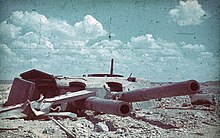Röchling shell

Röchling shells were bunker-busting artillery shells, developed by German engineer August Cönders during World War II, based on the theory of increasing the sectional density to improve penetration.[1]
Description
The fin-stabilised shells made from chrome-vanadium steel were able to penetrate much more than 4 metres (13 ft) of reinforced concrete roof before burying the shell through the floor and into earth.[2] However, these shells had a low muzzle velocity, and thus a high dispersion, 36 m (118 ft) on 1,000 m (3,300 ft) range. As a result, they saw very limited use during World War II; only about 200 shells were ever fired even though 6000 such shells were made for the very large howitzers like the 21 cm mortar.[citation needed]
Röchling shells were developed for the 21 cm Mörser 18, a captured French 34 cm railway gun 674(f), and the 35.5 cm Haubitze M1 only. In addition, many experimental HE shells were made for the 37mm PAK and 50mm PAK weapons.[3]
Use
Röchling shells were tested in 1942 and 1943 first against the Belgian Fort de Battice then against the Belgian Fort d'Aubin-Neufchâteau.[4][5] The Röchling shells were also tested against the fortresses of Hůrka,[6] Hanička and Dobrošov[7][8] (Czech Republic),[9] the Gössler wall, Toplitzsee (Austria) and at the Hillersleben test facility (Germany).
They were regarded as a German secret weapon, and there is speculation that their use was limited in order to reduce the chance of dud shells being recovered and exploited by the Allied forces.[10] A more likely reason, however, is their poor accuracy.[11]
See also
References
- ^ "Das Röchling-geschoss". Waffen Revue (in German). Vol. 72. 1988. pp. 73–106.
- ^ Georg, Friedrich (2005). Hitler's Miracle Weapons: The Secret History of the Rockets and Flying Crafts of the Third Reich Volume 2 - from the V-1 to the A-9; Unconventional Short- and Medium-Range Weapons. Helion Limited. p. 212. ISBN 9781874622628.
- ^ "Die Roechlingranaten des Heeres". www.balsi.de. Retrieved 2016-08-03.
- ^ "Premier obus flêchette". Les Canons de l'Apocalypse (in French). 30 December 2012. Retrieved 2016-08-03.
- ^ Delacruz, Jean-Paul. "Les étranges obus du fort de Neufchâteau". Reliques:souterrains et industries (in French).
- ^ "Artillery fort Hůrka - Röchling projectile embedded into the wall". Flickr. Retrieved 2016-08-03.
- ^ Čermák, Ladislav. "Bunkry.cz - Protibetonové Granáty Röchling". www.bunkry.cz. Retrieved 2016-08-03.
- ^ Čermák, Ladislav. "Bunkry.cz - Dělostřelecká tvrz Dobrošov". www.bunkry.cz. Retrieved 2016-08-03.
- ^ Jiricek, Pavel; Foglar, Marek (2015-01-01). "Numerical simulation of the effect of regular and sub-caliber projectiles on military bunkers". EPJ Web of Conferences. 94. doi:10.1051/epjconf/20159404049. ISSN 2100-014X.
- ^ Keegan, John (1990). Encyclopedia of World War II. Gallery Books. p. 212. ISBN 97 80831753504.
- ^ War and Games. "V 3 – THE HIGH-PRESSURE PUMP GUN". Archived from the original on July 23, 2009. Retrieved 2009-12-15.
{{cite web}}: Unknown parameter|deadurl=ignored (|url-status=suggested) (help)
